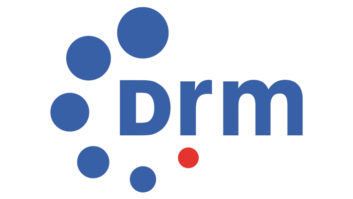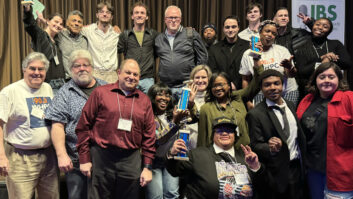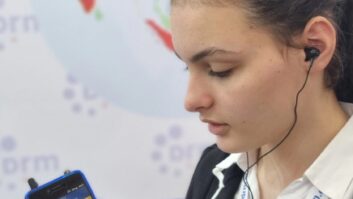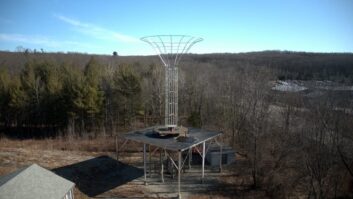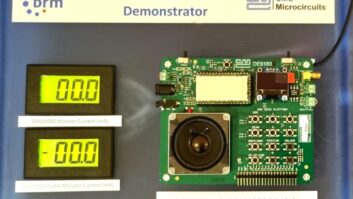EDINBURGH, Scotland — As part of an evaluation of digital radio systems, the BBC is testing DRM+ in Scotland.
Developed by the Digital Radio Mondiale Consortium and based upon the DRM30 standard for short-, medium- and longwave broadcasting, DRM+ is devised for use in VHF frequencies.
DAB is well established as a digital radio standard in the United Kingdom (and DAB+ is finding favor in other nations) thanks to its ability to provide wide-area coverage for multiple services; however, many smaller stations feel the DAB multiplex model does not scale well to their operations.

The Craigkelly tower as seen from Granton Harbour in Edinburgh across the Firth of Forth from Fife. Photo by Adam Fowler. Used under a Creative Commons license. DRM+ is being offered as an alternative digital broadcasting platform for smaller stations or in areas where only a limited number of services are on the air. Not only can it work in the same VHF Band II frequencies used by FM stations, DRM+ has also been demonstrated in VHF Band I and VHF Band III.
The Edinburgh tests follow previous DRM+ tests in Kaiserslautern (Band III) and Hannover (Band II), Germany; Paris (Band I); São Paulo, Brazil (Band II); Colombo, Sri Lanka (Band II); and Turin, Italy (Bands I and II).
Earlier tests
The Hannover VHF Band II tests were some of the first conducted outside the laboratory for DRM+, operating at a power level of just 30 W on 95.2 MHz. The goal of these tests was to verify the real-world technical parameters of the DRM+ signals and to check their compatibility with FM radio broadcasting, aircraft navigation systems and emergency service communications.
In addition, the early tests also looked at issues such as required protection ratios between DRM+ and FM signals operating in the same area and at mobile reception performance.
One big advantage of DRM+ over traditional FM transmissions is that single-frequency network (SFN) techniques can be used easily, therefore, in Hannover, the performance of SFN networks was also tested.
In November 2010, a brief series of mobile reception tests was conducted in Colombo, Sri Lanka, on 87.6 MHz with an ERP of just under 50 W.
With 2.5 kW ERP FM signals from Real Radio on 87.8 MHz operating in the same area, these tests allowed for an investigation of the effects of FM interfering signals on DRM+ performance. Near the Real Radio transmitter site, DRM+ reception dropped out, but despite the low-power output involved, the DRM+ signals remained largely robust up to approximately 9 kilometers (about 5-1/2 miles) from the originating transmitter site.
The Edinburgh tests built on the results of these and the other earlier experiments and were specifically intended to develop experience of high-power DRM+ operations and to explore system performance in the presence of high-power FM transmissions to serve the same area and broadcast from the same transmitter site.
Operating with a Test & Development License provided by the U.K. broadcast regulator Ofcom, the DRM+ transmissions occupied the 107.0 MHz frequency, which had previously been used by the now closed commercial radio station, Talk107.
The test broadcasts were transmitted from the 125-meter mast at the Craigkelly transmitter site, operated by broadcast transmission service provider, Arqiva. Located north of the Firth of Forth near the town of Burntisland, the site is not far from Edinburgh. The DRM+ test transmissions lasted for more than three months, using mixed polarization and realistic operational power levels of up to 1 kW ERP.
For the tests, an RFMondial DRM+ modulator and Fraunhofer Content Server used together with a Nautel NV5 transmitter. Arqiva handled the transmission site and antenna, as well as installation and commissioning of the system, while the BBC served as project manager and handled measurement and analysis. Signals were monitored with receivers from RFMondial and the Korea Electronics Technology Institute (KETI).
Multiple services
Built in 1971 and also home to television and DAB radio services, the Craigkelly transmitter site is home to various public and private FM radio services, including Radio Forth (97.3 MHz), Real Radio (101.1 MHz), BBC Radio nan Gàidheal (104.1 MHz) and Capital FM (105.7MHz). Having these various services operating from the same location as the DRM+ transmissions allowed for a range of tests to be carried out into the impacts of DRM+ signals on FM signals and vice versa.
Beyond the testing of compatibility issues among transmissions, the Edinburgh DRM+ trials had a number of other objectives, including comparing the relative coverage of FM and DRM+ for a given radiated power output and measuring the relative coverage of the system in various transmission modes (lower capacity, higher signal ruggedness or higher capacity, lower signal ruggedness, etc.).
A further advantage of the Craigkelly transmitter is that its coverage includes a range of terrain environments, urban, suburban and rural, sea paths, flat and hilly terrain. This variety provided opportunities to analyze the performance of DRM+ signals in the presence of multipath interference, terrain shielding, natural and man-made obstructions, in both strong and weak signal areas.
Because it is a functional, professional transmission site, the performance of the antenna systems used is fully catalogued. During the tests, it was possible to correlate and compare DRM+ performance in different directions with previous known FM system performance.
Overall, the objective of the tests was to provide accurate measurement data suitable for use by international regulatory bodies, such as the European Conference of Postal and Telecommunications Administrations (CEPT) and the International Telecommunications Union (ITU).
Different QUAM modes
Project managed and measured by the BBC, the Edinburgh tests used two different quadrature digital modulation schemes at different times, both occupying a 100 kHz channel (rather than the 200 kHz required for traditional FM stereo transmissions).
In 4-QUAM mode, the DRM+ transmissions carried a 50 kbps payload (low capacity with higher robustness) and in 16-QUAM mode, this capacity increased to a 150 kbps payload (high capacity with lower robustness).
In the 4-QUAM mode, the trial service carried the audio of BBC Radio nan Gàidheal at 45 kbps, with a separate data stream transmitted for receiver bit error rate (BER) analysis. In the 16-QUAM mode, the trial service carried BBC Radio nan Gàidheal at a higher rate of 70 kbps, plus a separate continuous music service at the same data-rate, again with a separate datastream transmitted for receiver BER analysis.
Mobile reception measurements were made over a wide area using receivers mounted in a specially adapted vehicle.
Although the final test results from Edinburgh were not available as this article was prepared, the general tone of the reports available to date is one of considerable satisfaction. The DRM+ signals did not impact significantly on the operation of FM transmissions radiated from the same site or cause other unexpected problems.
A final report is expected to be presented to the ITU by the DRM Consortium later in the year, and there is little doubt that it will help promote interest in this new digital broadcasting technology in a variety of countries over the coming months.






